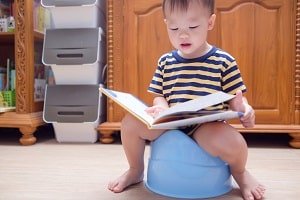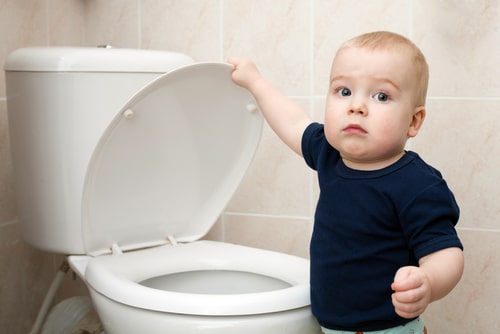© 2021 Gwen Dewar, all rights reserved
In Western countries like the United States, many children begin toilet training sometime between 24 and 36 months. But from an historical and cross-cultural standpoint, this timing is very late, and it comes with a downside.
So what’s the right potty training age? It depends on your child, your goals, and what trade-offs you’re willing to make.
In this article I cover:
- the “normal” age to train, and how this age varies across cultures and historical time periods;
- why when you train matters less than how you train; and
- the pros and cons of toilet training at different stages of development, from infancy to 24 months — and beyond.
Getting started: What’s the normal age to toilet train a child?
“Normal” is a slippery concept. It varies from one culture to the next.
For instance, in parts of Africa and Asia, it’s normal for children to begin learning toileting routines very early — often within 4-12 weeks of birth (Sun and Rugolotto 2004).
In Russia, it has been traditional to start toilet training months later, during the latter half of an infant’s first year (Karkashadze et al 2012).
And in Western Europe and English-speaking North America?
Children typically begin toilet training sometime between 24 and 36 months (e.g., Blum et al 2003; van Nunen et al 2015; Vermandel et al 2008; Sejokora et al 2020).
What’s normal also varies considerably between subcultures within the same society.
For example, when researchers interviewed approximately 780 parents living in Washington, D.C., they asked parents to weigh in on the most appropriate age to begin training. And the answers? As the researchers (Horn et al 2006) explain, they varied by ethnicity:
“Caucasian parents believed that toilet training should be initiated at a significantly later age (25.4 months) compared with both African-American parents (18.2 months) and parents of other races (19.4 months).”
And a society’s norms change over time.
To see what I mean, consider how the timing of toilet training in the United States has shifted over the last 70+ years.
In 1947, approximately 60% of children had finished toilet training by the time they were 18 months old (Martin et al 1984).
But by the 1980s, approximately 70% of kids hadn’t even started potty training by that age. The average child wasn’t finished training until he or she was between 24 and 27 months old (Seim 1989).
Fast forward again — to 2004 — and one study of more than 400 U.S. children reports that the average age of completion was nearly 37 months (Blum et al 2004).
And elsewhere?
Researchers in other Western countries have observed similar historical trends — a tendency for toilet training to occur at increasingly later ages over time (Bakker and Wyndaele 2000; Horstmanshoff et al 2003).
For example, between the 1950s and the 1980s, the median age for starting toilet training in Switzerland increased by 13 months (Largo et al 1996).
Why has the timing of toilet training been pushed back in these countries?
Researchers aren’t entirely sure. The availability of convenient, disposable diapers probably has something to do with it. And we know there was a change in the culture, the rise of a new belief that toilet training should be “child-centered,” or initiated by the child.
But hang on. Isn’t there a strong medical argument for delaying toilet training until a child is at least 2 years old?
If you grew up in a society where late toilet training is the norm, you might assume that. But in my years of following the research, I haven’t found compelling evidence that children will have better medical outcomes if we delay training until 24 months or later.
On the contrary, as I note below, the most up-to-date research leans the other way: Children who train earlier tend to experience fewer long-term problems with incontinence.
Of course, older kids have advanced developmental abilities, so they are able to learn more toileting advanced skills. They require less intensive assistance when they use a potty.
But that doesn’t mean that we can’t — or shouldn’t — train younger children. It’s just a reminder that we need to approach toilet training differently depending on the developmental status of the child.
So how should a parent make this decision? Is it purely a matter of personal preference?
Not exactly.
When it comes to choosing a potty training age, you have several options. But once you decide on the timing, your remaining choices aren’t entirely free.
For example, you aren’t going to train a 4-month-old baby in the same way that you would train a 18-month-old toddler. Or a 28-month-old child. The way you train — the approach you take — is going to be shaped by your child’s developmental abilities and needs.
It’s also important to delay toilet training if your child suffers from health problems — like constipation — that affect elimination.
And it’s crucial to adjust your expectations to your child’s individual circumstances. As we’ll see, what it means to be “toilet trained” varies a great deal, depending on your child’s age.
How, then, should you decide? You need to know more about the challenges associated with toilet training at different developmental stages.
In the rest of this article, I will compare the advantages and disadvantages associated with four potty training age groups:
- Infants (0-12 months)
- Young toddlers (12-18 months)
- Older toddlers (18-24 months)
- Children over 24 months
Infant potty training: 0-12 months

In countries like Kenya, Tanzania, India, China, and Vietnam, the traditional potty training age is early infancy (deVries and deVries 1977; Bouke 2003; Sun and Rugolotto 2004).
What does the process look like?
It begins with observation. Parents learn to recognize their babies’ body signals, and they use these signals to anticipate when their babies will eliminate.
Then, whenever an infant is ready, the parent holds the baby over a sink, bowl, toilet, or the open ground.
As the infant voids, the parent makes a characteristic sound or gesture. The goal is to train the baby to associate voiding with this parental sound or gesture.
And once the baby has learned that association, the parent can use the sign to communicate. Now the parent has a way to request that a baby void on cue.
You can read more about these traditional methods — sometimes called “elimination communication” — in this Parenting Science article.
As you can see, this arrangement isn’t what many people mean by “toilet training.”
To many, “toilet training” means teaching a child to remove his or her pants, sit on a potty chair, wipe, and so forth. It means teaching skills that young babies aren’t yet ready to develop. So the traditional method of infant toilet training is necessarily a more modest affair: staying dry with lots of parental assistance.
Is it worth it — all that parental supervision and vigilance?
That’s something that parents will have to decide for themselves. But there are definitely some advantages to consider.
The immediate benefits are pretty obvious. Babies never wear diapers, so they avoid the rashes and infections associated with diapers. Their parents save time and money on diapering. And going diaper-free is good for the environment.
But there are other, less obvious benefits too.
Research hints that children are less likely to experience recurring urinary tract infections if they were toilet trained during infancy. Why?
It’s probably because toilet-trained infants learn to empty their bladders completely — eliminating any residual urine that can harbor bacteria. Children who don’t begin training until after the age of 24 months may not learn this habit until their third birthdays (Duong et al 2013).
And there’s evidence that infant trainees are at a somewhat lower risk for developing problems with incontinence later in life (Wang et al 2020).
Finally, some parents view infant training as an investment. Yes, you have to be very vigilant now. But by training your child early, you save yourself a lot trouble later.
When kids grow up wearing diapers, they don’t learn to pay special attention to their body signals, like the sensation of a full bladder. In fact, they may learn the opposite. They may learn to ignore those feelings.
Kids may also develop a sense of familiarity and comfort in wearing diapers, making them more reluctant to wear underpants.
These factors can make it harder for older children to learn toileting skills. They have old habits to break. By contrast, if you start very early, your baby won’t have any bad habits to overcome.
So when does this traditional infant training typically begin?
In some cases, parents begin the process immediately after the newborn period, when the baby is 4 weeks old. Some don’t start until babies are 3 months old, or even older (Boucke 2003; Duong et al 2013; Sun and Rugolotto 2004).
Is this “traditional” method the only way to approach infant toilet training? What if you want to sit your child on a potty chair?
Once your child has learned to sit up independently — straight and steady, with no wobbling — you can try using a potty chair.
This seems to have been the traditional approach in many Western countries before the historical shift to late training.
For example, research suggests that most Swiss infants in the 1950s were being trained to sit on potty chairs by 6-9 months (Largo and Stutzle 1977).
And many Russian babies today begin sitting on potty chairs before they are 12 months old (Karkashadze et al 2012).
If you’re interested in using a potty chair, make sure that you adjust your methods so that they are appropriate for your infant’s developmental level. This Parenting Science article outlines a procedure that has been tested by researchers.
Older infants and young toddlers (12-18 months)

As we’ve seen, it’s not unusual — historically and cross-culturally — for parents to begin toilet training during a baby’s first year.
But what about starting a bit later? During the first half of your baby’s second year?
That timing isn’t nearly as common, and it’s made me wonder. Is there something about this age range that makes potty training more difficult?
For children in this age group, toilet training is necessarily about learning to sit on a potty chair. And that’s where some families might run into trouble.
It isn’t that their children can’t sit. It’s that they don’t want to.
For example, a study conducted in the United States found that children between the ages of 15 and 19 months were more resistant to sitting on potty chairs than were older kids (Sears et al 1957).
And I’ve found an interesting parallel in Russia, where parents usually begin toilet training before 12 months. According to researchers there, parents often complain that formerly cooperative children become resistant to sitting on potties at around 14 months of age (Karkashadze et al 2012).
What’s going on? It might have something to do with motor development.
Between 12 and 18 months, many children are learning to walk. So some pediatricians wonder if these toddlers are simply too excited or restless to sit on a potty chair. They’d rather walk around (Brazelton and Sparrow 2004).
But whatever the cause of the resistance, it’s important to respond appropriately.
Heavy-handed attempts to force compliance aren’t the answer. They can provoke bad feelings about the process, and make your child even more emotionally resistant to sitting on a potty.
So it’s better to back off if your child actively resists, and resume training only if you find a way to use positive reinforcement — to motivate your child through encourage, praise, and other rewards.
It’s also important to have realistic expectations.
Children under the age of 18 months are not going to achieve true toileting independence. To stay clean and dry, they need regular, frequent reminders to visit the potty. And they require our ongoing help with things like removing clothing, wiping, and washing up.
And if you decide to skip these months — to delay training for a later date?
You can still put the time to good use.
The interval between 12-18 months is the perfect time to start thinking about toilet training readiness — the set of skills and interests that will help your child master advanced toilet skills later on. You can make potty training easier if you actively prepare your child months in advance. For tips, see this Parenting Science article.
Potty training between 18-24 months

As I mentioned above, children who are resistant to sitting on a potty chair may become more compliant after 18 months. So is this interval — 18 to 24 months — a promising one for toilet training?
Many Western pediatricians say yes — if your child is showing signs of “toilet training readiness.”
What are these signs?
I’ve compiled a checklist, based on the recommendations of several sources, including the American Academy of Pediatrics. You can see the full checklist here.
But the quick answer is that the signs include major developmental milestones (like the ability to walk), as well as evidence that your child is motivated: Your child asks to use a potty chair, or tells you that he or she wants to wear “big kid” underpants.
How important are the signs? Should you really wait for them?
The answer depends on what your goals are.
If your goal is for your child to walk into the bathroom and sit on the potty independently, then you obviously should wait until he or she can walk.
If you’re interested in a more modest goal — something closer to the parent-assisted dryness we’ve discussed so far — then you may want to skip the wait.
But keep in mind. There’s one sign of readiness that seems especially predictive of long-term success: A child’s awareness of body signals, and ability to communicate about them.
In a study tracking the progress of 270 toddlers, researchers found that only three signs of readiness predicted toilet training success. One promising sign was if a child could pull his or her pants on and off. Another was if a child showed pride in doing things independently.
But the most predictive sign of them all was if a child “expresses a need to evacuate and shows awareness of the need to void or have a bowel movement” (Wyndaele et al 2020).
So if your child isn’t yet showing these crucial abilities, it makes sense to foster them. Talk with your child about the sensations that accompany elimination, and teach your child the vocabulary needed to express these feelings.
For tips about this — and about other aspects of toilet training readiness — see my article, “Toddler potty training: How to get your child ready.”
And whenever your child finally begins, remember that it will take a long time before your child has the skills and maturity to go “solo.”
Even after they complete training, most children aren’t ready to go to the bathroom unattended until they are at least 36 months old (Gesell and Ilg 1943; McKeith 1973; Bakker 2002; Schum et al 2002).
Potty training after 24 months: Understanding the pros and cons

As I noted at the beginning of this article, there’s been a historical shift in the United States and other Western countries. Most parents today are delaying potty training until their children are at least 24 months old. Is this beneficial to families? To children?
There’s at least one, potential advantage for waiting this long: You’re child is more developmentally advanced, so your child will more quickly acquire the skills needed for true toileting independence.
You may still need to adjust your expectations. Remember that most kids will continue to need our assistance with toileting until they are at least 36 months old. But by 24 months, many kids are ready to start learning advanced toileting skills — like pulling their pants up and down; wiping; and washing their hands.
Another potential advantage: Older kids may train faster.
When researchers tracked the development of more than 250 American children, they found kids tended to complete training more quickly if they started after the age of 24 months (Schum et al 2002).
Another study, tracking more than 400 American kids, likewise found that older kids completed their training in less time (Blum et al 2003).
But it’s important to note: Late toilet training has been linked with a higher risk of developing bladder problems.
For example, studies in multiple countries have reported links between late training and a higher probability of experiencing bladder problems, including daytime incontinence after the age of 5 years (Barone et al 2009; Bakker 2002, Bakker et al 2002; Joinson et al 2009; Li et al 2020; Wang et al 2020).
Now keep in mind. We don’t yet know why these links exist. We can’t assume that later training, by itself, causes bladder problems.
But some intriguing clues have emerged.
For instance, in one study, researchers compared two groups:
- 47 Vietnamese children (who started toilet training early — usually by 6 months), and
- 57 Swedish children (95% of whom didn’t begin toilet training until they were at least 24 months old).
The researchers wondered if the timing of toilet training was linked with any developmental differences in bladder function. In particular, they wanted to know if children were in the habit of completely emptying their bladders during urination.
It’s an important habit, because when we don’t completely empty our bladders, the residual urine left behind puts us at greater risk of developing a urinary tract infection (Hellström and Sillén 2001).
So the researchers performed periodic tests on the children as they grew older, and there was indeed a marked difference between groups.
The Vietnamese children — who had begun toilet training early — were completely emptying their bladders by the age of 9 months.
By contrast, the Swedish kids — who started toilet training after 24 months — didn’t learn to completely empty their bladders until they were 36 months old (Duong et al 2013).
So these are considerations to weigh and balance. What’s the takeaway? What are the most important things to remember?
Experts agree that you should choose a time when your child is
- healthy (no constipation, diarrhea, or urinary tract infections);
- relaxed (not stressed by new changes, like a move or new baby); and
- cooperative (not going through a rebellious phase).
In addition, it’s a good idea to actively prepare your child for toileting training. When kids are aware of their body signals, and ready to communicate about them, they are more likely to succeed.
Finally, no matter when you decide to toilet train your child, you need to have realistic expectations about the outcome.
Even after they are “trained,” young children will require a lot of assistance with toileting. And being trained doesn’t mean that a child never experiences set-backs or accidents. It is not unusual for children to experience occasional accidents into the school years (Kessel et al 2017; Wu 2013).
For more information about toileting, check out these Parenting Science articles:
- The science of toilet training: What research tells us about the timing
- Potty training techniques: An evidence-based guide to toilet training methods and their success rates
- Potty training problems and solutions: An evidence-based guide
And are you curious about nighttime dryness? See my article about wetting the bed.
References: Choosing the right potty training age
American Academy of Pediatrics. 1999. Toilet Training Guidelines: Parents−−The Role of the Parents in Toilet Training. Pediatrics 103;1362
Axelrod MI, Larsen RJ, Jorgensen K, Stratman B. 2020. Psychological differences between toilet trained and non-toilet trained 4-year-old children. J Spec Pediatr Nurs. e12319.
Bakker E; Wyndaele JJ. 2000. Changes in the toilet training of children during the last 60 years: the cause of an increase in lower urinary tract dysfunction? British journal of Urology, 86(3):248-52.
Bakker W. 2002. Research into the influence of potty training on lower urinary tract dysfunction. Unpublished MD dissertation, Department of urology, University of Antwerp, Belgium.
Bakker E, van Gool JD, van Sprundel M, van der Auwera JC, and Wyndaele JJ. 2002. Results of a questionaire evaluating the effects of different methods of toilet training on achieving bladder control. British Journal of Urology, 90: 456-461.
Barone JG, Jasutkar N, Schneider D. 2009. Later toilet training is associated with urge incontinence in children. J Pediatr Urol. 5(6):458-61.
Blum NJ, Taubman B, and Nemeth N. 2003. Relationship between age at initiation of toilet training and duration of training: A prospective study. Pediatrics, 111: 810-814.
Blum NJ,Taubman B,Nemeth N. 2004. Why is toilet training occurring at older ages? A study of factors associated with later training.JPediatr. 145:107-11.
Boucke L. 2003. Infant Potty Basics. Lafayette, CO: White-Boucke Publishing.
Brazelton TB and Sparrow JD. 2004. Toilet training the Brazelton way. Cambridge, MA: deCapo Press.
Canadian Pediatric Society. 2000. Toilet learning: Anticipatory guidances with a child-oriented approach. Paediatrics and Child Heath, 5: 333-5.
deVries MW and deVries MR. 1977. Cultural relativity of toilet training readiness: A perspective from East Africa. Pediatrics, 60: 170-177.
Duong TH, Jansson UB, Holmdahl G, Sillén U, Hellström AL. 2013. Urinary bladder control during the first 3 years of life in healthy children in Vietnam–a comparison study with Swedish children. J Pediatr Urol. 9(6 Pt A):700-6.
Gesell A and Ilg FL. 1943. Infant and child in the culture of today: The guidance of development in home and nursery school. New York: Harper and Brothers.
Gladh G, Persson D Mattsson S and Lindstrom S. 2000. Voiding pattern in healthy newborns. Neurourology and urodynamics, 19: 177-184.
Hellström AL and Sillén U. 2001. Early potty training advantageous in bladder dysfunction. Decreases the risk of urinary infection. Lakartidningen. 98(28-29):3216-9.
Horn IB, Brenner R, Rao M, and Cheng TL. 2006. Beliefs about the appropriate age for initiating toilet training: Are their racial and socioeconomic differences? Journal of Pediatrics, 149: 165-168.
Horstmanshoff BE, Regterschot GJ, Nieuwenhuis EE, Benninga MA, Verwijs W, and Waelkens JJ. 2003.[Bladder control in 1-4 year old children in the the Eindhoven and Kempen region (The Netherlands) in 1996 and 1966]
Joinson C, Heron J, Von Gontard A, Butler U, Emond A, Golding J. 2009. A prospective study of age at initiation of toilet training and subsequent daytime bladder control in school-age children. J Dev Behav Pediatr. 30(5):385-93.
Karkashadze G, Baranova L, Maslova O, Klochkova U, Zorkin S, and Komarova E. 2012. Formation of toilet skills of children in Russia. Problem analysis. Pediatric pharmacology. 9. 99. 10.15690/pf.v9i2.256.
Kessel EM, Allmann AE, Goldstein BL, Finsaas M, Dougherty LR, Bufferd SJ, Carlson GA, Klein DN. 2017. Predictors and Outcomes of Childhood Primary Enuresis. J Am Acad Child Adolesc Psychiatry. 56(3):250-257.
Largo RH, Molinari L, von Siebenthal K, and Wolfensberger U. 1996. Does a profound change in toilet-training affect development of bowel and bladder control? Dev Med Child Neurol. 38: 1106-16.
Largo RH and Stutzle W. 1977. Longitudinal study of bowel and bladder control by day and at night in the first six years of life. I: Epidemiology and interrelations between bowel and bladder control. Dev Med Child Neurol. 19(5):598-606.
Li X, Wen JG, Shen T, Yang XQ, Peng SX, Wang XZ, Xie H, Wu XD, Du YK. 2020. Disposable diaper overuse is associated with primary enuresis in children. Sci Rep. 10(1):14407.
Li X, Wen JG, Xie H, Wu XD, Shen T, Yang XQ, Wang XZ, Chen GX, Yang MF, Du YK 2020. Delayed in toilet training association with pediatric lower urinary tract dysfunction: A systematic review and meta-analysis. J Pediatr Urol. 16(3):352.e1-352.e8.
Martin JA, King DR, Maccoby EE, and Jaklin CN. 1984. Secular trends and individual differences in toilet-training progress. Journal of Pediatric Psychology 9: 457-468.
McKeith R. 1973. How children become dry. Child Dev Med., 48/49: 3-32.
Mota DM, Barros AJ. 2008. Toilet training: methods, parental expectations and associated dysfunctions. J Pediatr (Rio J).;84(1):9-17.
Schum TR, Kolb TM, McAuliffe TL, Simms, MD, Underhill, RL and Lewis M. 2002. Sequential acquisition of toilet-training skills: A descriptive study of gender and age differences in normal children. Pediatrics 109: 48-54.
Schmidt BA. 2004. Toilet training: Getting it right the first time. Contemporary Pediatrics, 21: 105-119.
Sears RR, Maccoby EE, and Levin H. 1957. Patterns of childrearing. Evanston, Ill.: Row, Peterson and Company.
Sears W, Sears M and Watts Kelly C. 2002. You can go to the potty. Boston, MA Little, Brown and Company.
Seim HC. 1989. Toilet training in first children. Journal of Family Practice, 29(6): 633.
Sejkora EKD, Igler EC, and Davies WH. 2020. Parent-reported toilet training practices and the role of pediatric primary care providers. J Am Assoc Nurse Pract. 2020 Jun 23. doi: 10.1097/JXX.0000000000000410. Online ahead of print.
Sun M and Rugolotto S. 2004. Assisted infant toilet training in a western family setting. Dev Beh Ped 25:99 – 101
Taubman B. 1997. Toilet training and toileting refusal for stool only: A prospective study. Pediatrics, 99: 54-58.
van Nunen K, Kaerts N, Wyndaele JJ, Vermandel A, Hal GV. 2015. Parents’ views on toilet training (TT): A quantitative study to identify the beliefs and attitudes of parents concerning TT. J Child Health Care. 19(2):265-74.
Vermandel A, Van Hall G, Van der Cruyssen K, Van Aggelpoel T, Neels H, De Win G, De Wachter S.J. 2020. ‘Elimination signals’ in healthy, NON toilet trained children aged 0-4 years: A systematic review. Pediatr Urol. 16(3):342-349.
Vermandel A, Van Kampen M, Van Gorp C, Wyndaele JJ. 2008. How to toilet train healthy children? A review of the literature. Neurourol Urodyn. 27(3):162-6
Wyndaele JJ, Kaerts N, Wyndaele M, Vermandel A. 2020. Development Signs in Healthy Toddlers in Different Stages of Toilet Training: Can They Help Define Readiness and Probability of Success? Glob Pediatr Health. Published online ahead of print. Jan. 2020, doi:10.1177/2333794X20951086.
Wang XZ, Wen YB, Shang XP, Wang YH, Li YW, Li TF, Li SL, Yang J, Liu YJ, Lou XP, Zhou W, Li X, Zhang JJ, Song CP, Jorgensen CS, Rittig S, Bauer S, Mosiello G, Wang QW, Wen JG. 2019. The influence of delay elimination communication on the prevalence of primary nocturnal enuresis-a survey from Mainland China. Neurourol Urodyn. 38(5):1423-1429.
Wu HY. 2013. Can evidence-based medicine change toilet-training practice? Arab J Urol. 11(1):13-8
Yeung, CK, Godley ML, Ho, CK, Ransley PG, Duffy PG, Chen CN, Li AK. 1995. Some new insights into bladder function in infancy. British Journal of Urology, 76:235-40.
Content of “The timing of toilet training: What’s the right potty training age?” last modified 2/2021
Portions of this text appeared in an earlier version of this article, written by the same author and posted on the same URL.
Title image of baby holding toilet lid by AlohaHawaii / shutterstock
Image of Hmong mother with infant in sling, Vietnam, by EoNaYa / istock
Image of baby girl running in living room with dad by monkeybusinessimages / istock
image of boy reading on potty by yaoinlove / istock
image of child on potty (no head) by Saklakova / istock
